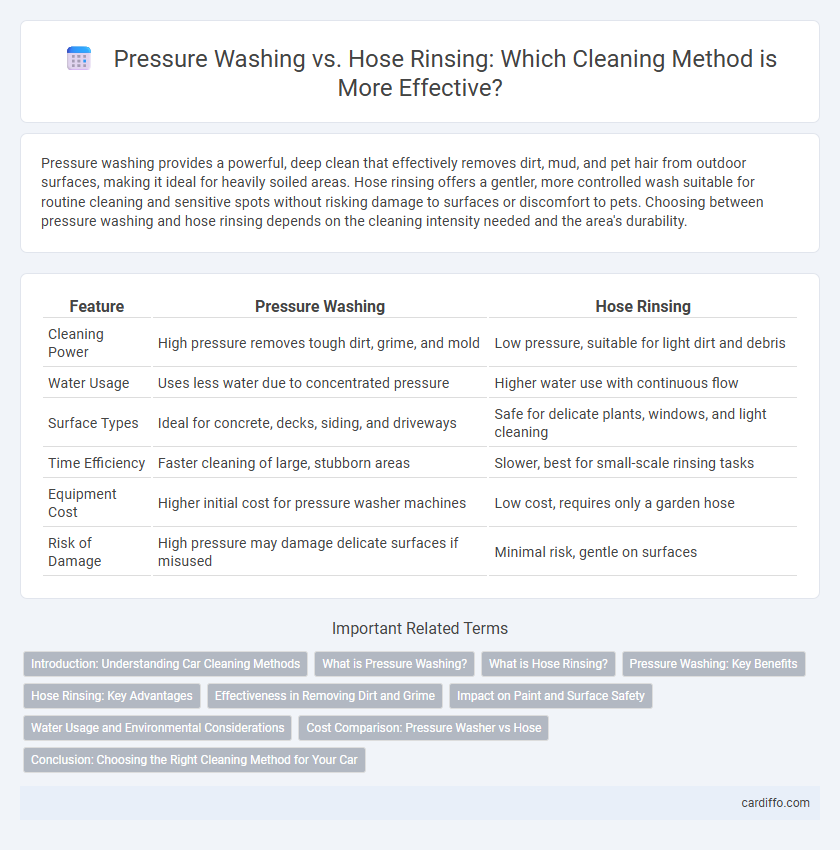Pressure washing provides a powerful, deep clean that effectively removes dirt, mud, and pet hair from outdoor surfaces, making it ideal for heavily soiled areas. Hose rinsing offers a gentler, more controlled wash suitable for routine cleaning and sensitive spots without risking damage to surfaces or discomfort to pets. Choosing between pressure washing and hose rinsing depends on the cleaning intensity needed and the area's durability.
Table of Comparison
| Feature | Pressure Washing | Hose Rinsing |
|---|---|---|
| Cleaning Power | High pressure removes tough dirt, grime, and mold | Low pressure, suitable for light dirt and debris |
| Water Usage | Uses less water due to concentrated pressure | Higher water use with continuous flow |
| Surface Types | Ideal for concrete, decks, siding, and driveways | Safe for delicate plants, windows, and light cleaning |
| Time Efficiency | Faster cleaning of large, stubborn areas | Slower, best for small-scale rinsing tasks |
| Equipment Cost | Higher initial cost for pressure washer machines | Low cost, requires only a garden hose |
| Risk of Damage | High pressure may damage delicate surfaces if misused | Minimal risk, gentle on surfaces |
Introduction: Understanding Car Cleaning Methods
Pressure washing delivers high-powered water jets that effectively remove dirt, grime, and stubborn contaminants from vehicle surfaces, making it ideal for deep cleaning. Hose rinsing uses lower water pressure for gentle cleaning, suitable for removing loose debris and light dust without risking damage to paint or delicate parts. Choosing the right method depends on the car's condition, surface sensitivity, and desired cleaning depth.
What is Pressure Washing?
Pressure washing uses high-powered water jets, typically ranging from 1,300 to 4,000 PSI, to remove dirt, grime, mold, and mildew from surfaces like concrete, wood, and siding. Unlike hose rinsing, which relies on low-pressure water flow, pressure washing effectively cleans deep-seated debris and stubborn stains. This method accelerates the cleaning process while reducing the need for harsh chemicals, making it an efficient and eco-friendly solution for outdoor maintenance.
What is Hose Rinsing?
Hose rinsing involves using a standard garden hose to spray water over surfaces, primarily to remove loose dirt and debris without applying high pressure. This method is suitable for light cleaning tasks on delicate surfaces, where excessive force could cause damage. Compared to pressure washing, hose rinsing is less effective on stubborn stains or heavy grime but conserves water and reduces the risk of surface erosion.
Pressure Washing: Key Benefits
Pressure washing uses high-pressure water jets to effectively remove dirt, mold, mildew, and stubborn stains from surfaces, ensuring a deeper clean than hose rinsing. This method saves time and water by targeting grime with precision, reducing the need for harsh chemicals and repeated cleaning. Pressure washing extends the lifespan of exterior surfaces such as driveways, decks, and siding by preventing buildup damage and maintaining aesthetic appeal.
Hose Rinsing: Key Advantages
Hose rinsing offers a gentle yet effective method for removing surface dirt and debris without the risk of damaging delicate materials, making it ideal for routine garden and outdoor cleaning. It conserves water compared to high-pressure washing and reduces the likelihood of stripping paint or causing surface erosion. This technique is highly accessible, requiring only a standard garden hose and nozzle, contributing to lower maintenance costs and ease of use.
Effectiveness in Removing Dirt and Grime
Pressure washing delivers a high-powered stream of water that effectively removes deep-seated dirt, grime, and mold from surfaces such as driveways, decks, and siding. Hose rinsing, while useful for light debris and surface dust, lacks the force to eliminate stubborn contaminants embedded in porous materials. For thorough cleaning and restoration of heavily soiled areas, pressure washing provides superior effectiveness compared to hose rinsing.
Impact on Paint and Surface Safety
Pressure washing uses high-pressure water jets that can effectively remove dirt but may risk damaging paint and delicate surfaces if not properly controlled. Hose rinsing applies gentler water flow, preserving paint integrity and minimizing surface abrasion, making it safer for regular maintenance. Choosing the right method depends on surface type and paint durability to balance cleaning effectiveness with protection.
Water Usage and Environmental Considerations
Pressure washing uses significantly less water compared to hose rinsing, typically consuming 2 to 5 gallons per minute versus up to 10 gallons per minute for hose rinsing, making it a more water-efficient cleaning method. The high-pressure spray effectively removes dirt and contaminants, reducing the need for harsh chemicals that can harm the environment. Pressure washing minimizes water waste and runoff pollution, contributing to better water conservation and reduced ecological impact.
Cost Comparison: Pressure Washer vs Hose
Pressure washing typically involves higher upfront costs, including the purchase or rental of a pressure washer ranging from $150 to $600, compared to a standard garden hose that costs between $20 and $50. Operating expenses for pressure washers include electricity or fuel consumption and maintenance, while hose rinsing mainly incurs minimal water costs and occasional replacement of nozzles. Over time, pressure washers provide more efficient cleaning for tough grime, potentially reducing labor costs, whereas hose rinsing may require longer time and water usage, impacting overall expenses.
Conclusion: Choosing the Right Cleaning Method for Your Car
Pressure washing offers a powerful and efficient way to remove stubborn dirt, grime, and road salt from your car's surface, ensuring a deeply cleaned finish that hose rinsing alone cannot achieve. Hose rinsing provides a gentler option ideal for regular maintenance and delicate finishes, minimizing the risk of paint damage or water spots. Choosing the right cleaning method depends on the severity of dirt buildup, the car's paint type, and the desired thoroughness of cleaning to maintain optimal vehicle appearance and protection.
Pressure washing vs Hose rinsing Infographic

 cardiffo.com
cardiffo.com